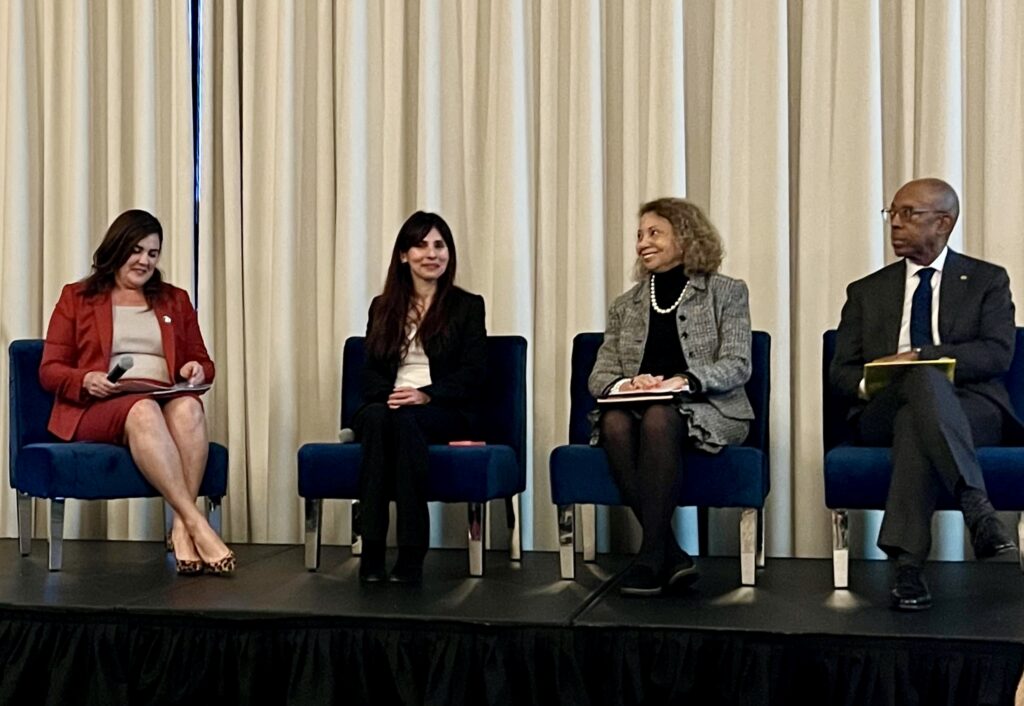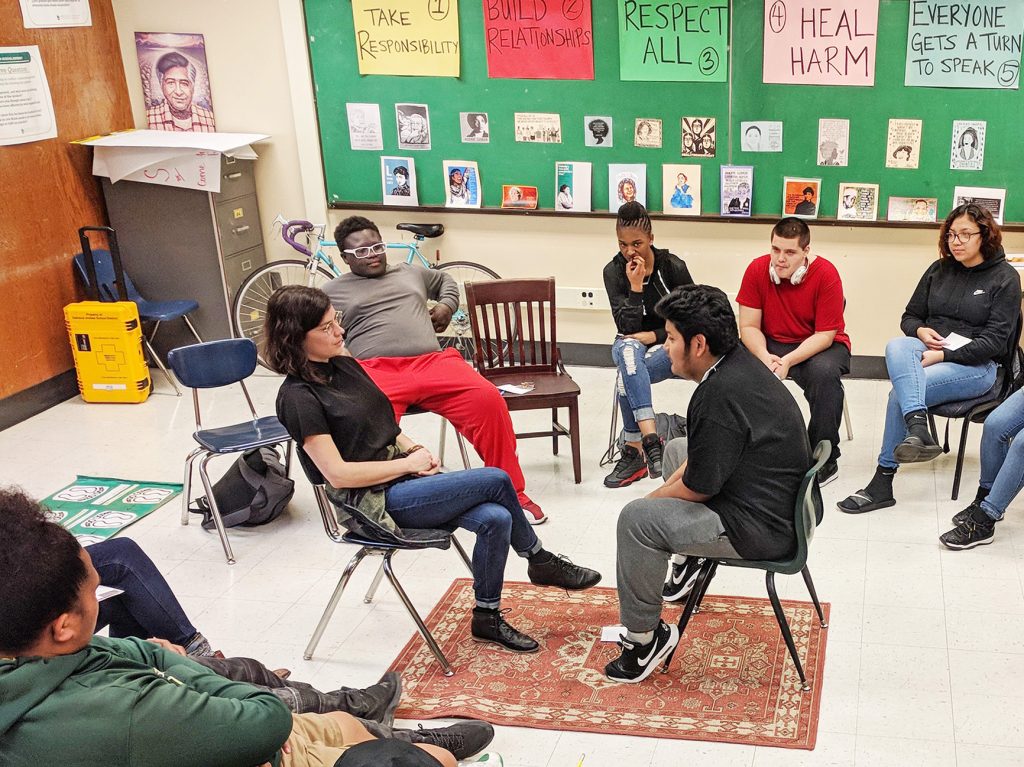
Michele Siqueiros, president of the Campaign for College Opportunity, hosts a panel discussion with California Community Colleges Chancellor Sonya Christian, California State University Chancellor Mildred Garcia, and University of California President Michael Drake.
Credit: Ashley A. Smith / EdSource
With some of the most racially and ethnically diverse student bodies in the country, California’s public community colleges and universities fail to mirror its students in teaching and leadership positions.
White men dominate the leadership positions within the University of California, California State University and California Community College systems, even as two-thirds of undergraduates across the state identify as Latino, Black, Asian or Native Hawaiian and Pacific Islanders, according to a new report released Tuesday by the Campaign for College Opportunity.
Notably, the three systems are each led by a person of color: a Black man at UC, an Afro-Latina at Cal State and an Indian-American woman at the community colleges, but the report highlights that those leading academic senates, tenured positions, departments and senior administrative positions are disproportionately white and male.
Seeing instructors, staff members, administrators and presidents from diverse backgrounds on college campuses has been shown to help all students perform better academically, the campaign’s research shows.
“I have often found a disheartening lack of representation while going to school, particularly as a STEM major,” said Casey Chang, an environmental science major at Mission College in Santa Clara. “I’ve had a few professors who are Asian American men, but navigating higher education as a woman of color has been difficult. I have yet to take a class with a female Asian American professor, and it feels like my identity has been left out.”
Chang spoke at an event Tuesday evening hosted by the campaign about the report.
Autumn Alaniz-Wiggins, a student at Chico State University, said she was excited to study nutrition, access and food justice at the school. But when she started her classes, she found that instead of learning about the intersection of systemic racism and food swamps, her instructors focused on the benefits of kale and quinoa.
“It became clear to me that the absence of diverse identities in faculty and leadership positions hindered us from equitable student access,” she said. And for a year, Alaniz-Wiggins dropped out of college. That is, until she met her first Black faculty member at Chico State.
“He taught culturally relevant courses and even hired me as a research assistant where I became published through a study on nutritional knowledge and (low-income) students,” she said. “For the first time, I was getting the support that I needed from the start.”
For the Campaign for College Opportunity, improvement is too slow.
“California’s public colleges and universities as well as our governor and Legislature have prioritized and invested in efforts to increase the representation of faculty and college leaders, but the work is, at best, happening at a pace that is far too slow or at worst, only paying lip service to the values of diversity, equity and inclusion,” said Michele Siqueiros, president of the Campaign for College Opportunity. Despite small increases in the racial and ethnic diversity of faculty and college leadership, “troubling gaps” remain, she added.
The report found that while there have been improvements in gender and racial representations since the campaign’s first report in 2018, the state’s public universities still need to improve diversifying their leadership positions. For example, Latino, Black, Asian, Native Hawaiian and American Indian professors are underrepresented among the tenured and tenure-track faculty groups across the community colleges, UC and CSU systems.
The UC system
There are few Latino faculty members in the UC system, and only 8% of them are tenured or on the tenure track. Among Black faculty, only 3% are tenured or on the tenure track.
Only eight of 117 campus leaders in the UC system are Latino, compared with 25% of UC students who identify as Latino, 39% of all Californians and 49% of Californians aged 18 to 24.
When it comes to women in leadership, only two of the nine undergraduate campuses are led by women, despite 54% of undergraduate UC students identifying as women.
The Cal State system
Only 10% of Latino faculty across the 23 CSU campuses are tenured or on the tenure track.
The report also found that the CSU’s academic senate is also overwhelmingly white. Seventy percent of the Academic Senate and 64% of the campus-wide academic senate members are white, despite white students comprising 21% of the undergraduate student body.
California’s community colleges
Only 18% of Latino faculty across the state’s 116 community colleges are tenured or on the tenure track. Among Black faculty, only 4% are tenured or on the tenure track.
Asian and Native Hawaiian-Pacific Islander students comprise 14% of the state’s community college students, but only 8% of campus or district leaders are Asian or Native Hawaiian.
California Community Colleges Chancellor Sonya Christian said she’s optimistic that in five years students will see an increase in diverse leadership across the 116 campuses.
“Tenure happens at the discipline level, not only at the college level,” she said. “As system leaders, we need to set the expectations and shift the mindset.”
Unfortunately, too often during the hiring process, people give arguments about not diminishing standards in the pursuit of diversity and equity, but “those are all false arguments,” Christian said. “We need to focus on what the data shows like the (report).”
UC President Drake said one way to improve the diversity of leadership positions is to encourage the diverse students within the three higher education systems to pursue careers in academia “through graduate school, to the junior faculty, to tenured faculty and to our leaders,” he said. “Those things are evolutionary and they take time. But all the energy’s moving in the right direction.”
Cal State Chancellor Mildred Garcia, hired at the end of last year, said she’s already starting to hold the 23 campus presidents accountable when it comes to making diversity, equity and inclusion a priority.
“We have to remember belonging because students do not understand our campuses,” she said. “What are you doing about your staff? And your senior team?”
But Garcia said campuses should also address the unconscious bias that happens on search committees. The UC system, for example, uses equity advisers in its hiring searches to guarantee a diverse and equitable pool of candidates, Drake said.
There have been some pockets of improvement in closing racial and gender disparities across the three systems. For example, Black Californians are represented in both tenured and non-tenured faculty positions in the community colleges at 6% for both groups, according to the report, which reflects the state’s Black population.
The share of tenured and tenure-track professors who are women has increased from 33% to 40% in the UC system and from 47% to 49% in the CSU. About half of CSU presidents are women and more than half of the CSU board of trustees identify as women. CSU presidents are also racially diverse, with 12 of 23 campuses led by Latino, Black, Asian and Native Hawaiian or Pacific Islander leaders.
Women also lead 52 of the 116 community college campuses, and 49% of presidents in the two-year system come from diverse backgrounds.
The campaign also recommended requiring all three public college systems to submit a bi-annual analysis of their leadership, faculty and academic senate diversity, and encouraged the Legislature to build a statewide fund that would help the colleges in recruitment, hiring and retention. The campaign also recommended that college presidents be willing to restart searches if their applicant pools don’t have an adequate number of competitive candidates from diverse backgrounds.



